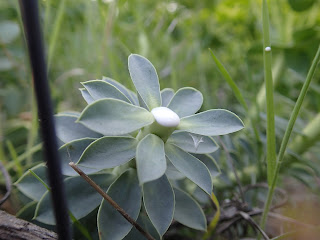A few days later, I went again to the park. Now I was able to see clearly that they had escaped from a nearby private garden. A virtual trail of plants lead from the fence-line of the garden. I spoke to a man that I found working in the garden, telling him about what I had learned about this plant and that it had been labelled a dangerously invasive weed, even legislated against in several of the arid western United States.
I then began documenting the infested properties that I saw in the West Kelowna area. They were easy to find; hundreds of patches of Myrtle Spurge could be seen in front-yard rockeries, roadsides and even in small areas of public ground, as seen from the car, as Herb and Martha and I drove along the streets. We spoke to a few people and the story was always about the same, They did not know the plant, only that it was attractive, hardy, and free for the taking. Neighbour gave it to neighbour.
The picture above and the one to the left were taken this year, in the Glenrosa area of Westbank.
Later, I was assisting Martha's sister, Ethel, to dig up irises in her garden in Oroville, Washington,
in preparation for moving and the sale of her home. We came upon a large clump of Myrtle Spurge. Ethel said that she did not know what it was, that some of these plants were on the property when she first moved there but that they had multiplied.
She pointed to the slope from an adjoining property. It was covered with Myrtle Spurge. I told her that the plant should be handled carefully, with gloves, as the plant is brittle and the white, latex-like sap is sticky and very irritating to skin and mucous membranes. Jessie, Martha's other sister who lives in Osoyoos, asked my help in removing the rest of the plants, rather than pass the problem on to a new purchaser. I now regret that I ducked the responsibility, so Jessie tackled the job on her own.
I regret that she was not adequately warned, for she did suffer a great deal from contact with the plant. She developed nasty blisters on her skin, was treated by a doctor (who, incidentally, knew nothing about the plant) and even now, several weeks later, she still feels the irritation from the poisonous sap.
Glen Canyon Regional Park management were informed and during the summer last year, a work crew of volunteers removed, bagged and disposed of all of the spurge plants that I had found in the park. On my trips to the park this year, I keep finding a few young seedlings. Yesterday, I found and removed 15 more (adjacent picture), some very tiny. These very young plants are easily confused with the noxious weed, Toadflax, also present in the area but the leaves of Myrtle Spurge have a more bluish tinge, while Toadflax, with similar form when young, is green.






No comments:
Post a Comment